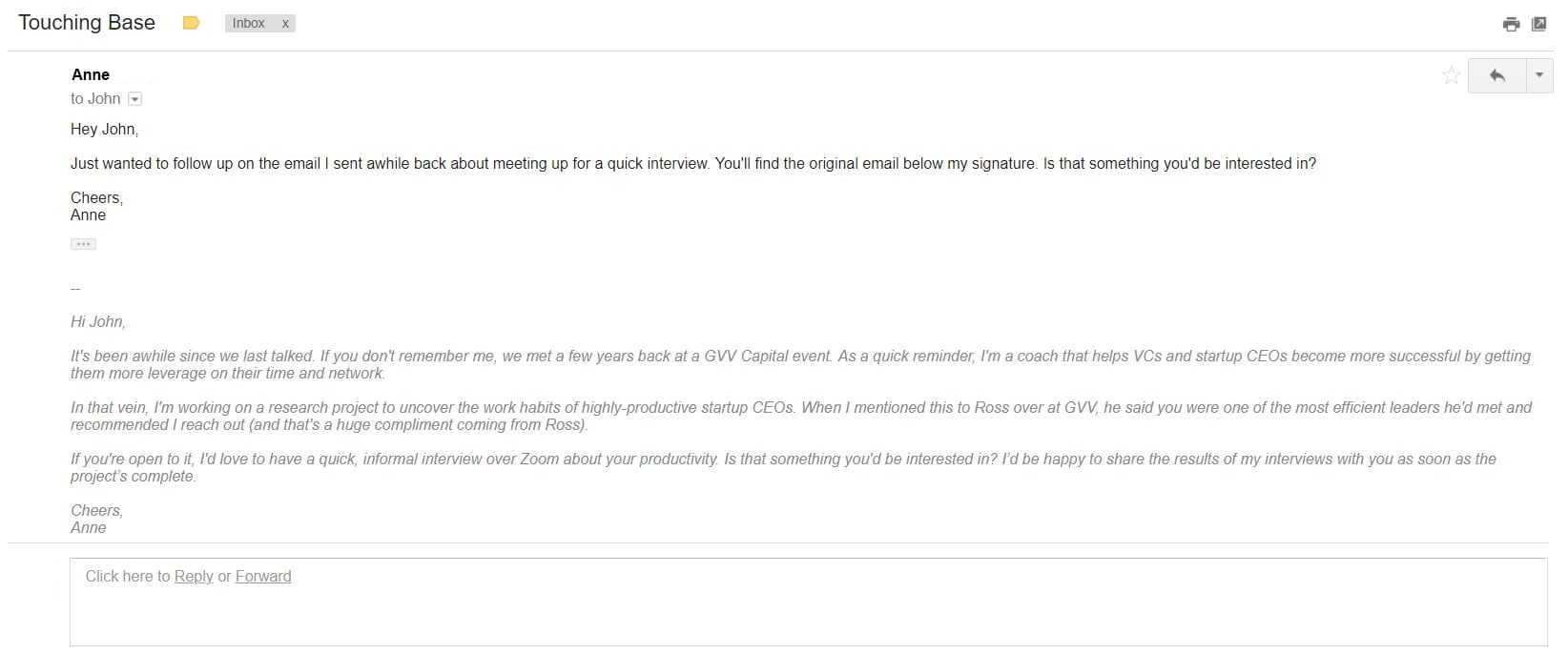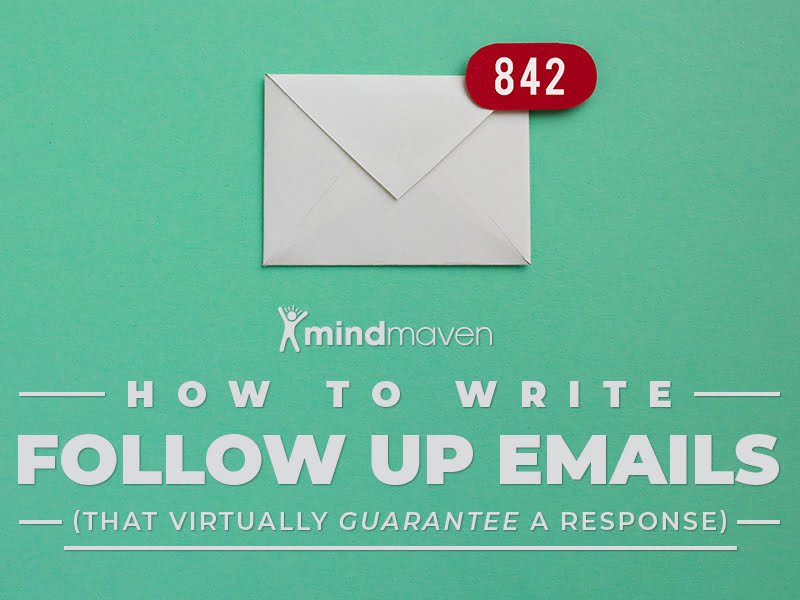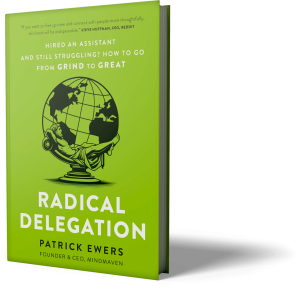How to Write Follow Up Emails That Virtually Guarantee a Response (with Templates!)
Ever spent what felt like ages drafting the “perfect” email, only to get nothing but radio silence in return? If you’re anything like most people, you probably have.
After all, a recent study found that the average person receives about 141 emails a day but sends only 40.
It doesn’t take a mathematician to realize that means 3/4th of the emails someone receives never get a response. The question is, how do you stack the deck in your favor to increase the odds of being a part of that coveted 1/4th?
Sure: How you write your initial email plays a big part in that, and we’ve already talked pretty extensively about how to write emails that get replies.
But at the end of the day, your initial email’s only half the battle. Even if you do everything right, you still may not get a response. And when that happens, the fortune’s in the follow up.
The problem is many people don’t know how to write follow up emails or when to send them. This uncertainty makes them uncomfortable, and, as a result, they often don’t end up sending anything (or they send something that’s ineffective at best).
Today, we’re going to show you how to write follow up emails, including three proven follow up email templates you can use to virtually guarantee a response from your recipient.
Note: This blog post is part of our new online program, The Email Response & Opportunity Generation Course. Click here to learn more!
First Things First: Get Over Yourself—It Isn’t Personal
But before we get into how to write follow up emails, there’s something important I want to point out. If you send an email that doesn’t get a response, don’t take it personally.
A lack of response doesn’t necessarily mean anything was wrong with your email, nor does it necessarily mean the other person is intentionally ignoring you.
In my experience, that’s rarely the case.
The truth is, the recipient probably saw your email and had every intention of responding. Just, later. When things slowed down. The problem is—despite their best intentions—by the time things finally slowed down hours (or even days) later, they simply forgot.
I know I’ve done that, and you may be guilty of that too.
So keep that in mind: As long as your original email is coming from a place of providing genuine value to the other person, you’ve got nothing to worry about.
They aren’t ignoring you, and you aren’t pestering them by sending a follow-up email (if you do it right). In fact, if you’re truly confident in the value you think you can provide this person, you’d be doing them a disservice by not following up.
So push through that initial discomfort, and I think you’ll find that many people actually appreciate the reminder.
How To Write Follow Up Emails: The 4-Week Follow Up Game Plan
And with that said, let’s get into the how to write follow up emails with the follow-up game plan.
Below, you’ll find how to write follow up emails with three separate examples. Note that these emails aren’t supposed to be interchangeable—they’re a sequence that should take place over a 4-week period (don’t worry, I’ll give you timing recommendations).
A quick note: These templates have been proven time and time again both in my experience, and the experiences of many of my clients. So although you certainly want to personalize the content to make it feel as though it’s coming from you, I recommend you don’t stray too far from the original messaging.
Follow-Up Email #1: The Quick Re-Ping
This first follow-up message should be sent 5 days after your initial email, and it serves a single purpose: To bring your name back to the top of their inbox.
It should be short, low-pressure, and guilt-free. From a content perspective, all you’re doing is summarizing the content of your initial email in a single sentence or two.
It’s also a good idea to include your original message at the bottom of this follow-up email so your recipient doesn’t have to dig through their inbox to find it. For example:

Subject: Touching Base
Hey John,
Just wanted to follow up on the email I sent awhile back about meeting up for a quick interview. You’ll find the original email below my signature. Is that something you’d be interested in?
Cheers,
Anne
In most cases, I think you’ll find a single follow-up message like the one above will be all it takes to get the reply you’re looking for. But if it doesn’t…
Follow-Up Email #2: The Friendly Check-In
The second follow-up email should come 7 days after the Friendly Re-Ping follow-up message.
Like the first, your goal here isn’t to guilt or blame the other person. In fact, this email should do the exact opposite. Give your recipient the benefit of the doubt and assume your messages are simply being lost somewhere. For example:

Subject: Did my email come through?
Hi John,
I wanted to send a quick message to follow-up on my email about connecting for a short interview.
Since I haven’t heard back yet, I’m wondering if you got the emails in the first place and I wanted to make sure they didn’t fall through the cracks (I know I’ve certainly missed a few emails that have been accidentally sorted into spam). It’d be great if you could send me a quick ping to let me know you received it. I’ve included the original email below.
Cheers,
Anne
Again, I recommend keeping this email in the same thread as your original follow-up message so they have all the context and information they need to reply directly to this email.
Follow-Up Email #3: The Last Chance
The final step in how to write a follow up email should be sent 14 days after the Friendly Check-In. At this point, it’s been almost 30 days; so it’s time to change up the approach a bit.
With this message, you’re looking to create a sense of urgency by taking your offer off the table. Let me give you an example first, then I’ll break it down into its core elements:

Subject: Checking in one more time
Hi John,
Since I haven’t had much luck reaching you via email, I thought I’d try a different channel. I just left you a voicemail following up on the research project email from a few weeks back.
If I haven’t heard back from you, I’ll assume it’s not the best time right now and stop following up on this matter. If I misread the situation and you are interested, shoot me a quick ping. I’ve included the original email below for your convenience.
Cheers,
Anne
As you can see, this email has two primary components:
- First, it assumes you’ve tried another medium to reach the recipient. Maybe email just isn’t their preferred method of communication, their spam filters are cranked up a little too high, or their inbox is simply too slammed. You can overcome this potential problem simply by trying a new outreach method, such as phone calls, texts, or social media.
- Second, it creates a sense of urgency and scarcity with the line, “If I haven’t heard back from you, I’ll assume it’s not the best time right now and stop following up on this matter.” If the recipient has any interest in whatever you’re offering or asking for, a line like that is almost guaranteed to get a response.
Wait: What if I Still Don’t Get a Response After These Emails?
The fact of the matter is—even with the right initial message and the follow up email game plan above—you still aren’t going to get a response to every email you send (especially when we’re talking cold emails).
If you haven’t received a reply after sending these three emails, it’s usually safe to assume now isn’t a good time for them. I recommend shelving your outreach attempts for 3-6 months—depending on the relationship and the context—and then trying again.
After all, until you get a clear “no,” you can always assume they’re still interested.
The Fortune’s in the Follow Up, But …
Keep in mind, that the three emails above are built on the assumption that you wrote an initial email worth responding to in the first place.
If you’re anything like myself and many of my clients, email is a foundational part of doing business—so it’s important to make sure you’re getting as much value out of this medium as possible.
To that end, my team and I recently launched our newest online resource, The Toolbox.
Along with a wealth of other valuable content, we have several phenomenal resources that dive deeper into how to write follow up emails and introduce you to other concepts. You’ll learn …
- Our proven method for creating emails quickly while delivering high-quality experiences and deepening relationships in our eDrafting Playbook.
- How to optimally craft thoughtful follow up emails that strengthen relationships with your own customizable Notion template.
- The 3 factors that determine the likelihood of getting an email reply, and how to influence them to achieve higher response rates.
- How to almost guarantee email replies with a simple hack, played out in a 2-minute video.
We hope you enjoy exploring all The Toolbox has to offer and hope this blog on how to write follow up emails has been valuable to you. Happy emailing!


